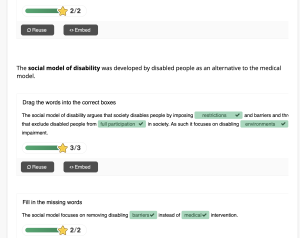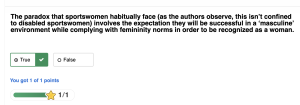5
Section one: The fundamentals
A)
Exercise 1: Notebook Prompt
Many of you are likely familiar with the concept of “ability inequity,” which the authors of this article define as “an unjust or unfair (a) ‘distribution of access to and protection from abilities generated through human interventions’ or (b) ‘judgment of abilities intrinsic to biological structures such as the human body’.”
However, they go on to identify the following “ability concepts” that are less familiar:
1) ability security (one is able to live a decent life with whatever set of abilities one has)
2) ability identity security (to be able to be at ease with ones abilities)
How prevalent are these forms of security among disabled people you know? Or, if you identify as a disabled person, would you say your social surroundings and community foster and support these kinds of security? Furthermore, while the focus of the article is on Kinesiology programs, it is also important to reflect on how academia in general accommodates for disability. If you feel comfortable answering this question, what has been your experience of postsecondary education to date?
-OR-
The authors also observe that “Ableism not only intersects with other forms of oppression, such as racism, sexism, ageism, and classism, but abilities are often used to justify such negative ‘isms’.”
What do you think this means? Provide an example.
|
The statement in the article is highlighting how ableism intersects with other forms of oppression, such as racism, sexism, ageism, and classism. What this means is that the way people with disabilities are treated or marginalized can be affected by other social categories, such as race, gender, age, or class. For example, a disabled person of color might face discrimination that is influenced by both their disability and their race. Moreover, the phrase that states “abilities are often used to justify such negative isms” suggests that societal perceptions of “normal” abilities, ,are often used to rationalize discrimination. In other words, if someone doesn’t meet the societal standards of ability, they might be marginalized more readily, and that marginalization can be furthered by other factors like race, gender, or socioeconomic status. |
Exercise 2: Implicit Bias Test
Did anything surprise you about the results of the test? Please share if you’re comfortable OR comment on the usefulness of these kinds of tests more generally.
| The ableism test did surprise me. The test ranked me as “moderately automatic preference too abled people compared to disabled people, which was much higher than I anticipated. I work with disabled children and have an invisible disability myself, and figured my subconscious was lest ableist then this test had ranked me. I try very hard to never discriminate, however if anything, this is enlightening and suggests maybe I have some work to do internally regarding my potential subconscious beliefs.
|
B) Keywords
Exercise 3:
Add the keyword you contributed to padlet and briefly (50 words max) explain its importance to you.
B) On Disability

Exercise 5: Notebook Prompt
What do Fitzgerald and Long identify as barriers to inclusion and how might these apply to sport in particular?
*(Couldn’t access reading)*
Barriers to inclusion
- physical ones (lack of ramps, inaccessible spaces or transportation
- Forms of communication (no sing language, pictures or technology to aid with communication
- Stigma o lack of education
- social exclusion
…
C) Inclusion, Integration, Separation

Exercise 6: Complete the Activities
Exercise 7: Notebook Prompt
Choose ONE of the three questions Fitzgerald and Long argue disability sport needs to address and record your thoughts in your Notebook.
- Should sport be grouped by ability or disability?
- Is sport for participation or competition?
- Should sport competitions be integrated?
|
The debate over whether sports should be grouped by ability or disability centers on fairness, inclusion, and the nature of competition. On one hand, grouping sports by ability allows individuals to compete based on their skill level rather than their disability. This approach creates a more equitable and competitive environment. In many sports, physical ability is a factor in performance. Grouping athletes according to their abilities, rather than their disabilities, increases the chances of a level playing field where competitors face others with similar skills and physical capabilities. On the other hand, grouping sports by disability aims to promote inclusion and equal opportunities for athletes with disabilities. The physical limitations caused by a disability can significantly affect an athlete’s ability to compete against able-bodied individuals. This perspective is rooted in the principle of equity, which differs from equality. Equity focuses on providing tailored support and creating an environment where everyone has an equal chance to succeed, given their unique circumstances. By categorizing athletes based on disability, it ensures that everyone, regardless of physical differences, has a fair opportunity to excel in their sport. Ultimately, its difficult to decide which option is more favourable, and equitable. Both provide different opportunities that may benefit people differently depending on their diverse contexts.
|
Part Two: Making Connections
A) Gender, Sport and Disability

Exercise 8: Complete the Activity
The paradox that sportswomen habitually face (as the authors observe, this isn’t confined to disabled sportswomen) involves the expectation they will be successful in a ‘masculine’ environment while complying with femininity norms in order to be recognized as a woman.
True or false?
Take a moment to reflect on this paradox below (optional).
| True: Sportswomen face a dilemma where they are expected to succeed in “masculine” sports that emphasize strength and aggression, while also adhering to traditional femininity standards, like being attractive and graceful. This creates a conflict between being valued for their athletic abilities and meeting societal expectations of femininity, often resulting in criticism or internal struggles when unable to fulfill both roles. |
B) Masculinity, Disability, and Murderball
Exercise 9: Notebook/Padlet Prompt
Watch the film, Murderball and respond to the question in the padlet below (you will have an opportunity to return to the film at the end of this module).
The authors of “Cripping Sport and Physical Activity: An Intersectional Approach to Gender and Disability” observe that the “gendered performance of the wheelchair rugby players can…be interpreted as a form of resistance to marginalized masculinity” (332) but also point out that it may reinforce “ableist norms of masculinity.” After viewing the film, which argument do you agree with?
a) Murderball celebrates a kind of resistance to marginalized masculinity
| The film Murderball offers a complex interplay between challenging and reinforcing traditional masculinity (option d). On one hand, the film celebrates resistance to marginalized masculinity by showcasing athletes who embrace resilience, strength, and independence. These athletes redefine masculinity through their physicality, and determination, demonstrating that masculinity can transcend conventional physical abilities and be rooted in willpower. However, the film also reinforces certain masculine norms, particularly through the presence of aggression, and dominance. The athletes’ aggressive play and desire to “destroy” their opponents demonstrates ableist norms of masculinity including ideals of strength and power. Ultimately suggesting that even in the face of disability, masculinity remains tied to physical dominance and asserting dominance.
|
Section Three: Taking a Shot
A) Resistance
B) Calling out Supercrip
Exercise 10: Mini Assignment (worth 5% in addition to the module grade)
1) Do you agree with the critique of the “supercrip” narrative in this video? Why or why not? Find an example of the “supercrip” Paralympian in the 2024 Paris Paralympics or Special Olympics coverage and explain how it works.
|
I find the supercrip narrative in the video “Were the Superhumans?” from the 2016 Paralympics is inspiring but can be problematic. The supercrip narrative often portrays athletes with disabilities as exceptional or superhuman because they are able to overcome their impairments and perform incredible physical and mental skills. While these athletes certainly deserve recognition for their incredible achievements, this framing can be problematic as well. It tends to elevate them to an unrealistic standard, making their successes seem extraordinary and rare, which can ultimately reinforce the idea that disability is something that needs to be “overcome”. It shifts focus away from broader societal issues of accessibility, equity, and inclusion, and it doesn’t reflect the everyday reality of people with disabilities, who may not be elite athletes. Dipa Karmakar, a talented gymnast from India, is a good example of the supercrip narrative. This is due to the way her story is framed in the media, particularly regarding her achievement in gymnastics despite overcoming significant physical challenges (IOC, 2016). Known for performing the highly difficult vault at the 2016 Rio Olympics, Dipa’s success was widely celebrated as a “superhuman” acheivement, emphasizing her ability to defy the odds of her disability (IOC, 2016). The media focused on her triumph over physical limitations, portraying her as an inspiration for ‘overcoming’ her disability through extraordinary effort(IOC, 2016). However, this narrative risks reducing her to achievement to overcoming disability, rather than recognizing her skill and talent as a gymnast. This reinforces the idea that people with disabilities must perform exceptional acts to prove their worth, rather than addressing broader issues of accessibility and inclusion.
References IOC. (2016). Dipa Karmakar Biography, Olympic Medals, Records and Age. Olympics.com. https://www.olympics.com/en/athletes/dipa-karmakar |
2) Does the film Murderball play into the supercrip narrative in your opinion? How does gender inform supercrip (read this blog for some ideas)?
| In my opinion, Yes, Murderball does play into the supercrip narrative, as it showcases athletes with disabilities performing remarkable feats of strength and agility. The film emphasizes their resilience and determination, portraying them as “superhuman” which follows the supercrip narrative of overcoming their disabilities to compete at a high level. Similarily, this reinforced the idea that people with disabilities are valued for their ability to defy expectations. Gender plays a significant role in how the supercrip narrative is shaped. For example, in Murderball, the focus on male athletes reinforces traditionally masculine traits like aggression, and physical toughness; aligning with the expectations of mainstream masculinity. In contrast, when women are portrayed in the supercrip narrative, they are expected to embody emotional strength and perseverance alongside physical achievements, reflecting different gender norms. Thus, gender informs the “supercrip” narrative by imposing different pressures on male and female athletes, both expected to defy expectations and embody traits associated with their gender.
|


I learnt what the definition of pedagogy is in a previous class. If i remember correctly it is the approach chosen to provide teachings depending on a specific group of people. For example pedagogy involves understanding the context in which learning occurs, including the social, cultural, and emotional aspects that affect students’ engagement and understanding. It also takes into account different social roles, such as the relationship between teacher and student, and the classroom environment.